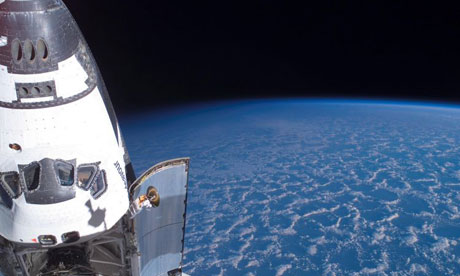
download large image (2 MB, PNG) acquired January 1, 2008 - December 1, 2008

download large image (120 KB, PDF) acquired January 1, 2008 - December 1, 2008
Calendar year 2008 was the coolest year since 2000, according to the NASA Goddard Institute for Space Studies (GISS) analysis of worldwide temperature measurements, but it was still in the top ten warmest years since the start of record-keeping in 1880. Given the range of uncertainty in the measurements, the GISS team concluded that 2008 was somewhere between the seventh and the tenth warmest year on record. (The 10 warmest years have all occurred within the 12-year period from 1997-2008.)
The map above shows global temperature anomalies in 2008 compared to the 1950-1980 baseline period. Below-average temperatures are shown in blue, average temperatures are white, and above-average temperatures are red. (Gray indicates no data.) Most of the world was either near normal or warmer than normal. Eastern Europe, Russia, the Arctic, and the Antarctic Peninsula were exceptionally warm (1.5 to 3.5 degrees Celsius above average). The temperature in the United States in 2008 was not much different than the 1951-1980 mean, which makes 2008 cooler than all of the previous years this decade. Large areas of the central and eastern Pacific Ocean were cooler than the long-term average, linked to a La Niña episode that began in 2007.
The graph shows the long-term trend in surface temperatures since 1880. The annual average temperatures are shown in light orange, and the jaggedness of the line indicates how much the average global surface temperature varies from year to year. Because climate is so variable form year to year, it can be easier to spot long-term trends through multi-year averages. The dark red line shows the five-year running average, which is an average of five years of annual temperatures centered on a given year. Even this five-year average shows that climate has ups and downs, but the long-term increase in global average surface temperatures is obvious. The gray “barbells” indicate the range of uncertainty. Not surprisingly, the uncertainty is larger for older measurements than for more recent ones.
In their report on 2008 temperature trends, the scientists at NASA GISS, led by James Hansen, attribute the relative coolness of 2008 to the persistent La Niña, which continued as of late 2008/early 2009. The summary also describes how the delay in the start of the next solar sunspot cycle, volcanic activity from Aleutian Island volcanoes (both Okmok and Kasatochi erupted in August), and emission rates of greenhouse gases could influence average global temperatures in the next few years.
NASA Goddard Institute for Space Studies. (2008, December 16). Global Temperature Trends: 2008 Annual Summation. Accessed January 20, 2009.
National Weather Service Climate Prediction Center


0 comments:
Post a Comment